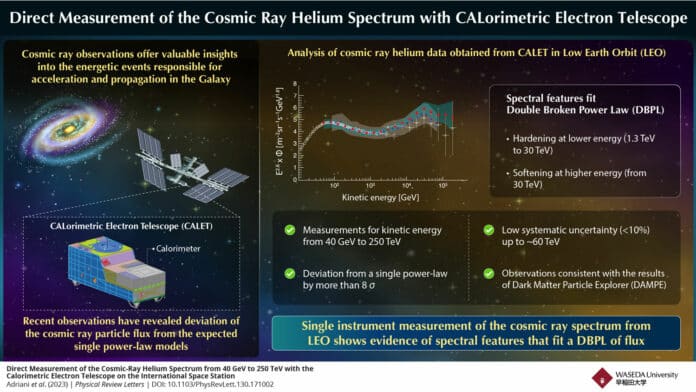Cosmic rays are high-energy charged particles composed of protons, electrons, atomic nuclei, and other subatomic particles. Studies have revealed that cosmic rays contain all the elements known to us in the periodic table, suggesting that these elements originate from stars and high-energy events such as supernovae.
Mainly, the magnetic field influences the path of cosmic rays through space. Detailed observations of cosmic rays can shed light on the origins of these particles and decode the existence of high-energy objects and phenomena such as supernova remnants, pulsars, and even dark matter.
A new study presents the results of directly measuring the cosmic-ray helium spectrum. An international team of researchers used the data collected by CALET. Analysis of the flux data gathered between 2015 and 2022 reveals that the energy distribution of cosmic ray helium nuclei follows a Double Broken Power Law, in contrast to the single power law that was previously thought to exist.
The particle flux of protons at high energies was much larger than anticipated in 2018, according to studies of the cosmic ray proton spectrum from 50 GeV to 10 TeV. The standard cosmic ray acceleration and propagation models, which assume a “single power-law distribution,” where the number of particles decreases with increasing energy, were diverted by these data.
As a result, the CALET team, which included scientists from Waseda University, discovered that cosmic ray protons with energies between 50 GeV and 60 TeV follow a “Double Broken Power Law.” According to this rule, the number of high-energy particles will initially rise to 10 TeV (a process known as spectrum hardening), then fall as the energy increases (a process known as spectral softening).
Extending these observations further, the team has found similar trends of spectral hardening and softening in the cosmic ray helium spectrum captured over a broad range of energy, from 40 GeV to 250 TeV.
Associate Professor Kazuyoshi Kobayashi from Waseda University, Japan, said, “CALET has successfully observed energy spectral structure of cosmic ray helium, especially spectral hardening starting from around 1.3 TeV, and the tendency of softening starting from around 30 TeV.”
These results, representing the most comprehensive energy range for cosmic helium nuclei particles to date, offer proof that the particle flux deviates from a single power-law model. The researchers observed that the deviation from the expected power-law distribution was more than eight standard deviations from the mean, indicating a very low probability that this deviation could have happened by coincidence.
Notably, the initial spectrum hardness shown in these data indicates that distinct sources or mechanisms may cause the acceleration and propagation of the helium nuclei to high energies. Recent data from the Dark Matter Particle Explorer also support the discovery of these spectral signatures, which calls into question our present theories about the origin and makeup of cosmic rays.
Professor Emeritus Shoji Torii said, “These results would significantly contribute to the understanding of cosmic ray acceleration in the supernova remnant and propagation mechanism.”
Journal Reference:
- O. Adriani, Y. Akaike, K. Asano, Y. Asaoka, E. Berti rt al. Direct Measurement of the Cosmic-Ray Helium Spectrum from 40 GeV to 250 TeV with the Calorimetric Electron Telescope on the International Space Station. Physical Review Letters, 2023; 130 (17) DOI: 10.1103/PhysRevLett.130.171002
